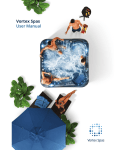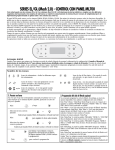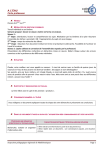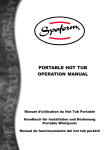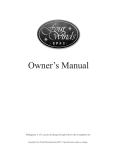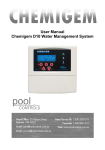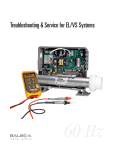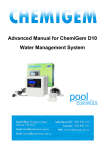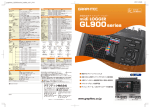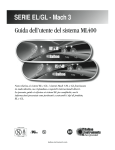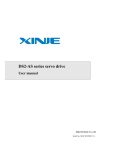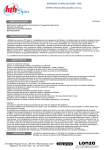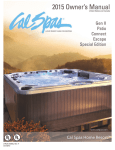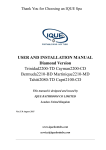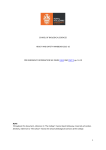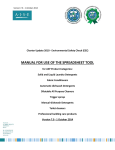Download Spaform_Owners_Manual
Transcript
IMPORTANT: READ THIS IMMEDIATELY Tubs t o H f o r e r u nufact a m t s e g r a Europe’s L STOP – BEFORE DOING ANYTHING!! YOUR SPA MUST BE TREATED WITH CHEMICALS IMMEDIETELY AS IT IS FILLING WITH WATER. Ensure that the installation has been carried out by a competent person and that any electrical work has been carried out by a qualified electrician to the current IEE regulations. The electrical isolator/connection must be at least 2 metres from the spa/water. The spa MUST be protected by a residual current device (RCD) with a 30mA trip that is rated to handle the total current requirement of the spa. The spa cannot be used without referring to this spa use manual. The spa must be maintained in accordance with the manufacturer’s recommendations as set out in this manual. DO NOT add chemicals to the water while persons are inside the spa. DO NOT smoke while handling or administering spa chemicals. DO NOT expose chemicals to a naked flame or excessive temperatures. Store in accordance with chemical manufactures guidelines. People with high blood pressure, heart disease, diabetes, expectant mothers or persons receiving medication should seek advice from their doctor before using the spa. Young children MUST be supervised at all times by a competent adult. DO NOT leave children or those with difficulty accessing/exiting (e.g. the elderly or disabled) in the spa unattended. To ensure maximum bather safety, all Spaform spas utilise pumps which are designed to draw the spa water from anti vortex safety points. These are situated around the inside of the foot-well of the Spa. Utmost care should be taken to ensure loose clothing or long hair are not allowed to be drawn into them– accidental drowning could occur. NEVER allow the spa to be used if the suction covers are removed or damaged. The consumption of alcohol or drugs in conjunction with spa use can greatly increase the risk of hyperthermia and subsequent drowning. People with infectious disease MUST NOT use the spa. DO NOT use the spa immediately following strenuous exercise. DO NOT allow pets into the spa. DO NOT polish the step or floor area of the spa; it may be hazardous if it is unusually slippery. When using detergents to clean your spa, or handling spa chemicals, always use protective gloves; wear the appropriate recommended eye and skin protection. Always follow the manufacturers instructions printed on the container/packaging. DO NOT allow electrical appliances to come into contact with water. DO NOT use appliances in the spa; including: telephone, audio/visual equipment, computer consoles, reading lamp, etc. The HSE [Health and Safely Executive] recommend a maximum water temperature of 44°C. IN THE EVENT OF WATER SCALDING: ÖRemove wet clothing. ÖApply cold water to the burns for 30 minutes (meanwhile contact help immediately if scalding is extensive or serious). ÖNEVER use oil, ointments or ice. ÖKeep the patient warm with a blanket. ÖSeek medical attention immediately if the hot water burn involves the face, hands or is larger than the palm of your hand. NEVER use automotive anti freeze in your spa system– always follow manufacturers guidelines for winter protection. Warning! Shock Hazard! No User Serviceable Parts. Do not attempt to service the control system. Contact your dealer or service engineer for assistance. Installation must be performed by a licensed electrician and all earthing connections must be properly installed. 2. Page Topic XUser Manual & Spa Care Guide ................................................ 1 Safety First ................................................ 2 Contents ................................................ 3 Introduction ................................................ 4 Choosing A Location For Your Spa ................................................ 4 Cleaning The Acrylic Shell ................................................ 4 Portable Spa System Components– Schematic Diagram ................................................ 5 Portable Spa System Components …............................................ 6-7 Filling The Spa …............................................ 8 Full Drain Down ................................................ 8 Prestige Range Control Touchpads • Button Functions: GL900/GL700/AX20 ................................................ 9-11 • Prestige Range Diagnostic Messaging ................................................ 11-12 Classic Range Control Touchpads • Button Functions: Elite M7- 4000 Series ................................................ 13-15 • Classic Range Diagnostic Messaging (Elite M7 Touchpad) ................................................ 15-16 • Button Functions: Digital Duplex M7– 3000 Series ................................................ 17 • Button Functions: Lite Leader– 2000 Series ................................................ 17-18 • Classic Range Diagnostic Messaging (Duplex And Lite Leader Touchpad) ................................................ 18 Filter Maintenance ................................................ 19 XWater Treatment & Chemical Dosing Guide ................................................ 20 Introduction; Spa Water Chemistry ................................................ 21 Sanitation Chemicals Explained: Their uses, advantages and disadvantages ................................................ 22 Chlorine Products– The Facts ................................................ 23 Bromine Products– The Facts ................................................ 24 Spa Water Chemistry– Achieving The Right Conditions • pH Overview, Ideal Spa pH Range, To Raise/Lower pH ................................................ 25 • Total Alkalinity Overview, Ideal TA Range, To Raise/Lower TA ............................................... 26 • Calcium Hardness Overview, Ideal CH Range, To Raise/Lower CH ............................................... 27 • Total Dissolved Solids (TDS) ............................................... 27 Other Spa Maintenance Chemicals ............................................... 28 Testing & Analysing Your Spa Water ............................................... 29 FAQ’s & Problem Solving Charts ............................................... 30-31 Warranty Registration Form ............................................... 33 Recommended Spa Water Conditions ............................................... 35 © Copyright Spaform Ltd 2005. All Rights Reserved. Not to be reproduced without prior permission from the copright owner. 3. Congratulations on selecting a Spaform portable spa; the health benefits that hydrotherapy will bring into you life and the many hours of pleasure to be experience from spa use are now yours. Your Spaform spa is manufactured to the highest standard from premium quality materials which we have carefully selected to provide a spa unit which is as maintenance free as possible. However, all mechanical equipment must be maintained to some degree and your new spa is no exception. Please ensure that this manual has been fully read and understood before proceeding to use the spa. This resource is designed to provide guidance on the day-to-day running of the spa as well as to give advice on routine maintenance to keep your spa in prime working order. This manual has been divided into two clearly distinct sections; the first section, User Manual & Spa Care Guide, deals with how your spa operates, the general maintenance of your spa and provides instructions on using the control system. The second section, Water Treatment & Chemical Dosing Guide, deals with the chemical treatment of your spa water and covers correct water management protocol as well as offering advice about the different chemical products available on the market. Careful consideration should be given when choosing a location for the spa. Refer to the Pre Delivery Instructions manual for detailed information. Preferably, the spa should be sited away from trees where falling leaves can quickly block the skimmer and filter. Where this is not possible, ensure that the skimmer/filter system is monitored more frequently. Ideally, choose a site for the spa in an area which is naturally sheltered. Where shelter is not available, consider using a gazebo or similar garden structure to provide year round protection from the elements. Ensure that there are no overhead obstructions/hazards immediately above the spa; this may be an accident risk. Remember, when using the spa steps to enter/exit the spa you may be as much as one metre higher than when standing on the ground. DO NOT place the spa in close proximity to a boiler flue outlet. PLEASE NOTE: Spas generate a large amount of water vapour due to the evaporation of the water surface. If your spa is situated indoors, suitable ventilation and humidity control should be installed. Excessive humidity can cause superficial and structural damage to buildings. Ensure that the spa is not used indoors beneath plaster ceilings. Condensing water can also increase the risks associated with electrical systems. The spa must be positioned on a solid, flat base capable of supporting the weight of the water-filled spa and bathers. A suitable electrical supply must be available and MUST be AT LEAST 2 metres from the spa. The Spa MUST be installed in accordance with the IEE regulations latest edition. A means of filling and draining the Spa should also be available and convenient to the spa. Please note that access to the spa components via the detachable cabinet panels is essential for routine servicing and maintenance and must never be obstructed by decking or other structures. Be mindful also of the location of the touchpad controls on the outer rim of the spa and audio/CD-player appliances if fitted; good visibility and easy access will provide the best results. The surface of the spa is very durable. It should not stain or suffer from osmosis (become turgid from water penetration), which can be the case with fibreglass spas. Acrylic requires only a minimum amount of maintenance. To clean the surface, use a non-abrasive cleaner and warm water. Once the spa surface has been cleaned, rise off to remove the soap/detergent, then once a week buff the spa with a recommended spa polish. Avoid wearing any metal objects, i.e. belts buckles, rings etc. as this may scratch the surface or chip the acrylic which may be irreparable. NOTE: DO NOT polish the step or floor area; it may cause a hazard if it is unusually slippery. If limescale develops, it may be removed by a mild acid solution. Talk to your local spa dealer for advice. Take great care to rise and remove any contaminated water from the spa before refilling. For this operation, always use protective gloves, wear the appropriate recommended eye and skin protection. Always follow the manufacturers instructions printed on the container/packaging. DO NOT leave the spa exposed and empty when ambient temperatures exceeding 36°C. DO NOT leave the spa exposed and empty when ambient temperatures are below 0°C– A residual amount of water may be remaining in the air track which will be susceptible to freezing and subsequently cause damage. The spa shell may also be damaged by elevated water temperature exceeding 45°C; although the thermostat only allows temperatures up to 40°C to be set. The maximum temperature allowed by the control system is 45°C; however, poor ventilation or locating the spa in an excessively warm environment may cause the water temperature to rise unpredictably. NOTE: If the water temperature continues to rise beyond 40°C and the heater is not running, e.g. the heater icon is not displayed on the touchpad (follow individual touchpad instructions for details), take action to reduce the ambient air temperature and increase ventilation by removing spa cabinet panels. Do not proceed to use the spa until the temperature has been successfully decreased to a safe level. 4. 10 9 11 8 4 6 5 7 6 13 12 14 1 4 2 3 Fill the spa with water to half way up the skimmer mouth 5. The range of Spaform portable spas utilise some generic components; these common features have been listed over the next two pages; including some information about features which are exclusive to the Prestige Range. These pages are not intended for use by the owner as instructions on servicing the spa; maintenance to the electrical/mechanical/plumbing system MUST always be carried out by a qualified, specialist engineer. However, this information will be useful in trying to familiarise the common portable spa system to aid communications with service engineers, dealers, etc. 1 Skimmer The spa water filtration system begins at the skimmer. The pump system draws water into the skimmer which contains two cartridge elements and a particle strainer-basket which is designed to trap large debris. 2 Cartridge Elements The two cartridge elements housed inside the skimmer are either of the 100Sq.ft. or 35Sq.ft. type and consist of a corrugated fabric mounted on a perforated hollow plastic spindle which is designed to trap fine particles that are suspended in the spa water. 3 Anti-vortex Inlets To ensure that 100% of the spa water is treated by filtration, water is also drawn from the foot-well of the spa through anti-vortex inlets (suctions) as well as through the skimmer. 4 Pumps The clean, filtered water passes through the 24 hour, continuous circulation pump which ensures that stagnant water is never allowed to lay in system. 5 Returns Residual Ozone and Spa Frog chemicals are reintroduced into the spa water through independent return jets. 6 Circulation Jets Heated air and water is circulated around the spa system 24 hours a day through dedicated circulation jets. This prevents the build-up of stagnant water in the spa pipe-work which is a potential health risk. 7 Mixing chamber Ozone and water flow through a mixing chamber where bacteria and other contaminants are oxidised and destroyed. 8 Ozone Injector An injector system that works on the venturi principle, introduces the ozone into the spa-water stream. 9 Ozonator Ozone (O3) is a bacteria killing gas that is effective as both a sanitiser and oxidiser and is introduced into the spa water by an ozonator device which is integrated into the water circulation system. An ozonator works by bombarding pressurised dry oxygen molecules from the air with Ultra Violet light to produce Ozone. Ozone is the most powerful oxidiser available and kills bacteria instantly. Control Box This is the ‘brain’ of the spa where filter cycles are programmed, temperature is controlled and pumps can be activated via the control touchpad. 11 Spa Frog In-line water treatment is provided by the Spa Frog. This is a device which contains two separate disposable cartridges; bromine, which is used as a sanitiser and minerals which aids the efficiency of bromine as a sanitiser. This device can be set to a range of different dose-release-rates to suite each individual location’s water conditions. 12 Blower A heated blower-unit produces warm air which is either forced through the dedicated air injectors (small, perforated pepper-pot-like components located around the seating of the spa) to create a gentle bubbling sensation, or using the variboost control, air can be combined with the water being propelled through the hydrotherapy jets to intensify the massage. 13 Air Loop The connecting pipe-work from the blower to the air injectors incorporates an above-water-level air loop which, due to the effects of gravity, provides an effective one-way-system preventing water from the air injectors flowing the wrong way and damaging the blower. 14 Variboost Control The Variboost control can be used to select three options; to allow for air from the blower to be ’injected’ through all of the air injector fittings; to divert air to the hydrotherapy jets where a mixture of water and air is created for an alternative massage sensation; or a combination of both. Spa shell All of the portable and commercial spas in the Spaform product range are manufactured from seamless sanitary grade acrylic [PMMA] using the vacuum thermoforming process. All Spaform acrylic spa shells are glass-fibre reinforced using a spay application roving mixed with a specialist resin. The resin we use was developed specifically for spa bath applications with input from Spaform engineers. Following the glass-fibre reinforcing, a layer of foam insulation is applied which acts as both heat and sound insulation. Spa Cabinet All framework is constructed from redwood; this is specially treated with copper and organic biocides, which makes it extremely durable; it is perfectly suited to outdoor applications and gives long term protection against fungal and insect attack. The panels and corner pieces of the Prestige Range are constructed from extruded recycled styrene which has the visual and textural appearance of a wood-grain, is environmentally sound and requires no maintenance. The panels and corner pieces of the Classic Range are fabricated from redwood which is treated with a water based stain, which, unlike varnish, allows the wood to breathe naturally and therefore does not blister, flake of peel away over time. We recommend that the wood should be lightly sanded and a coat of finishing oil or water based stain applied at the beginning of each season. 6. Adjustable Jet Bodies The pressure level of the massage generated by all Powerstorm, Polystorm and Cluster jet types is adjustable. This is done by increasing or decreasing the resistance of the water flow through the jet. By rotating the outer jet body (as illustrated) anticlockwise, the massage becomes firmer; rotating the outer jet body clockwise, the massage becomes milder. Waterfall Prestige Range spas feature LED lit variable-flow waterfall(s). This special feature adds a tranquil ambience to your spa experience. To turn the waterfall on, simply rotate one of the nearest diverter controls. Tuff Base® Our all weather ABS plastic spa bases are extremely durable, are ideally suited to the outdoors and have the highest impact strength of all plastics. Pillows The pillows/head rests fitted to your spa are manufactured from a synthetic foam which can be degraded by high levels of Bromine/Chlorine, and or low pH levels. Please ensure that when administering a shock dose of chemicals or adding Chlorine or Bromine to the water that the pillows are not resting below or partly below the water level; if necessary, remove the pillows until the Chlorine/Bromine levels reduce. Spa Covers All Spaform spas are supplied with a folding, rigid-foam-insulated, imitation-leather cover. The cover has been designed to conserve as much heat in the spa water as possible. It is NOT a safety cover or a debris/snow cover. The cover will require additional means of support in the eventuality of heavy rain/snow. DO NOT allow children or pets to sit or stand on the cover– it will NOT support their weight. Note: poor water chemistry can degrade the rigid cover. To clean the imitation-leather surface, remove the foam inserts and use a specialist synthetic leather/vinyl cleaner inside and out. Rinse away any detergent residue and let dry thoroughly. A conditioning product, designed specifically for vinyl covers can then be applied to soften and protect the cover fabric. To clean the foam inserts, unzip the cover and slide out the foam. Use a mild soap/detergent or specialist product. Rinse away any detergent residue and let dry thoroughly. Do not leave the foam inserts in direct sunlight- they may deteriorate or even melt. When reassembling the cover, replace the foam inserts the opposite face-up than they were originally; inverting the foam inserts occasionally will help keep their shape. Soothing Scents – Fragrance Injector An innovative fragrance injection system is fitted to certain models within the Spaform Portable range. The range of fragrances are micro-engineered and encapsulated into plastic beads supplied in convenient disposable mesh bags. They are manufactured especially for spa use, simply place the bag into the dedicated fragrance dispenser. Warm air fed from the blower releases the discreet fragrance which defuses through the spa water and emerges as a gentle aroma above the water level. Mood Lighting Prestige Range spas feature the mood lighting system which consists of synchronised illuminated jet inserts and ambient spa lights which enhance the serenity of your spa experience or can be used to add some visual interest at parties etc. By pressing the light button on the control touch pad, a sequence of lighting options can be previewed; steady, majestic colour changes; flashing colours or individual static colours. Each of these can be viewed by turning the lights on and off; each time the lights are switched on a different lighting option in the cycle is activated. To return to a previous colour, simply turn the lights on and off until that particular colour/sequence is activated again. 7. Once the spa has been sited in the chosen location and connected to the electrical supply, the spa may be filled with water; chlorine or bromine must be added as the spa is filling with water (see: Water Treatment & Chemical Dosing Guide). It is absolutely essential that the Water Treatment section is read thoroughly and the requirements, especially levels of sanitizer and pH are maintained precisely all the time the spa is filled with water. The spa can be filled through a garden hose. Ensure that there is no stagnant water or debris in the hose by allowing fresh water to flush through for a few seconds prior to filling the spa. Fill with clean water to a level midway up the skimmer mouth (see page 5 for diagram). The spa must NOT be used until the correct water conditions have been achieved. NOTE: to aid mixing of the chemicals, switch on the filter pump and the blower (if fitted). Priming Once the spa has been filled with water, there may be air trapped in the pump, release the trapped air by opening the bleed valves. Prior to filling: check all pump and heater unions are tight. Check all Isolation Gate Valves are in the open position. Bleed Valve: Located on the Pump Return Union Isolation Gate Valve– open position Switch on the power to the system – The control touchpad will display Pr indicating pump priming mode; set all pumps to high speed to achieve the priming function. This will automatically run for 4 minutes. CAUTION: If the pumps have not been primed, i.e. water is not seen flowing from the jets within 2 minutes, turn off power at the mains and repeat priming process again by switching power back on to the system; this will initiate the priming process again. NOTE: A pump must never be allowed to run without priming i.e. without water flowing, for more than 2 minutes. Once the pumps have primed, turn off all pumps. Manually exit PR mode by pushing either of the / temperature. buttons. If PR mode is not exited manually, it will terminate automatically after 4 minutes. Ensure all pumps have primed before proceeding to the next stage. When PR mode has terminated, either manually or automatically, the display will briefly show the set temperature, then the system will display ‘-.’ The system will not display the water temperature at this point, this is not a fault. The system will monitor the water flow and temperature for 2 minutes prior to displaying the water temperature. The filter pump shuts down for a further 4 minutes; after which, the blower will start. This priming cycle will occur each time the supply is disconnected then reconnected to the spa. For details on setting the temperature, filter times and duration etc. please refer to the individual instructions under each control touchpad section. • • • • • • Add chlorine/superchlorinate to achieve a concentration of 10ppm in the water and circulate fully using all pumps. Operate the blower, if fitted, for a few minutes and allow the water to drain back into the air track. Connect a garden hose to the drain port, open the drain cock and drain the water completely out of the spa and pipe-work– tilt the spa to remove any water from the jet and air tracks if this can be done safely. Using an appropriate wet conditions vacuum unit remove any remaining water. This can be aided by turning on the air blower, which will force any remaining water out of the air track. Wipe dry. Drain all water from the pump via the bleed valve (pictured above). Cover the spa completely to protect it from possible water penetration. Note: Check that the spa does not have any stagnant water remaining in the shell or in the cabinet/base area. Flush out the shell with fresh water and drain it again if necessary. Mop out any water found within the cabinet and dry out completely. To re-commission the spa, follow the instructions for Filling The Spa. 8. Button Functions: GL900 / GL700 / AX20 Controls Pump 2 Increases spa water temperature Controls Pump 1 Controls Pump 2 Controls Blower Sets time and filter cycles Controls mood lighting sequence Indicates 1st filter cycle Indicates 2nd filter cycle Panel locked indicator Temperature locked indicator Spa mode selector Decreases spa water temperature LCD display Inverts LCD display How to set the time & filter cycles... Display Icon Legends: GL900 / GL700 Temperature icon– Indicates different stages of heating Press Then Select the hour by pressing: Blower icon– Symbol develops as speed increases or Jets icon– Rotates slowly on low speed, rotates faster on high speed (Each press changes time by 1 hour) Next, press Light icon– On/Off Select the minutes by pressing: Spa Model Main Touchpad Model Auxiliary Touchpad Model Prestige 30 ML700 AX20 Prestige 32 ML700 AX20 Prestige 48 ML900 AX20 Prestige 50 ML900 AX20 Prestige 55 ML900 n/a Prestige 75 ML900 n/a or (Each press changes time by 1 minute) Press To enter optional filter cycle programming Press To exit programming 9. Initial Start-up When your spa is first activated, it will start in Priming Mode. Please refer to the relevant sections Filling The Spa and Priming on page 8 for more information about these proceedings. The Priming Mode will last for up to 4 minutes after which, the spa will begin to heat-up then maintain the water temperature in Standard Mode. You can exit Priming Mode early by pressing “Warm” or “Cool.” Temperature (26.0 C - 40.0 C) The start-up temperature is preset to 37.5 C. The temperature is constantly displayed on the LCD. [Note: the last measured temperature is only current when the pump has been running for 2 minutes.] Warm/Cool Press the “Warm” or “Cool” button once to display the set temperature. Press either button again and the set temperature will increase or decrease depending on which button is pressed. After 3 seconds, the LCD will automatically display the last measured spa temperature. Filter Cycles On all systems, the pump and the ozone generator will run during filtration. At the start of each filter cycle, the blower [if fitted] will run for 30 seconds to clean out the air channels. Pump 2 and pump 3 [if fitted] will run for 5 minutes. There are two filter cycles per day. The start/finish times of each cycle are programmable. To program, follow the steps under the heading How to set the time & filter cycles on page 9, ensuring that you press “Mode/Prog” to advance to the next setting option. The factory default filter cycles are as follows: The first filter cycle is automatically activated at 8:00AM and operates the pump until 10:00AM. The ‘F1’ indicator icon on the control touchpad will be lit when filter cycle 1 is running. The second filter cycle is automatically activated at 8:00 PM (20:00) and operates the pump until 10:00 PM (22:00). The ’F2’ indicator icon will light when filter cycle 2 is running. Mode/Prog This button is used to switch between Standard, Economy, and Sleep modes. Press “Mode/Prog” to cycle to the desired mode [LCD flashes until confirmed,] then press “Mode/ Prog” to enter mode programming, press “Cool” to confirm selection. Standard Mode Constantly maintains the set temperature. Note: the displayed temperature is current only when the pumps have been running for more than 2 minutes. The STANDARD icon will display until another mode is selected by the operator. Economy Mode Heats the spa to the set temperature only during filter cycles. Pressing “Jets 1” while in Economy mode activates the Standard-in-Economy mode, which operates the same as Standard Mode for 1 Hour, then reverts back to Economy Mode automatically. During this time, pressing of the “Mode/Prog” ately. The ECONOMY icon will display until mode is changed. button will revert to back to Economy Mode immedi- Sleep Mode Heats the spa to within 11°C of the set temperature during filter cycles only. The SLEEP icon will be displayed until mode is changed. Standby Mode Pressing “Warm” or “Cool” Pressing any button will reset the spa. then “Jets 2” will turn off all spa functions temporarily. This is helpful when changing a filter cartridge. Jets 1 Press the “Jets 1” button once to turn pump 1 on or off. If left running the pump will turn off after 15 minutes. Jets 2 Press the ‘Jets 2” button once to turn pump 2 on or off. If left running the pump will turn off after 15 minutes. Jets 3 Press the “Jets 3” button once to turn pump 3 on or off. If left running the pump will turn off after 15 minutes. Blower Press “Blower” button to turn blower on/off. If left on, the blower will automatically turn off after in 15 minutes. Invert Invert allows the user to change the orientation of the display to allow the numbers to read the correct way up either from outside or inside the spa. Press the “Invert” button to flip the numbers on the display to read ‘up-side-down.’ Another press returns the display to normal ‘right-side-up’ display. 10. Light Press the “Light” button to switch the spa light on/off. Every time the light is turned on, a different colour in the sequence will be activated. The first option is a continuous sequence of all the colours, each remaining for a duration of 5 seconds then merging into the next one. Following this option are seven individual static colours which can be selected. The final option is a sequence of flashing lights. Circulation Pump The circulation pump operates continuously (24 hours) regardless of water temperature unless in Standby Mode. Ozone Generator Ozone runs continuously (24hr) with circulation pump unless Jets 1, 2, 3 or Blower is pressed; then activity is suppressed for 1 hour. Automatic Freeze Protection If the temperature sensors detect a drop to 6°C within the heater, then the pump automatically activates to provide freeze protection. The system stays on until 4 minutes after the sensors detect that the spa temperature has risen to 7°C or Higher. Locking the Panel Press ‘Time” “Jets 1” then “Warm” with 3 seconds one another. When locked, the ‘PL’ indicator light will light. All buttons are frozen except the “Time” button. To unlock the panel, press “Time”, “Jets 1” then “Cool”. Locking the Set Temperature Press “Warm” or “Cool” then “Time”, “Jets 1”, and “Warm” within 3 seconds of one another to activate the lock. The ‘TL’ indicator light will light when the set temperature is locked. To unlock the set temperature, press “Warm” then “Time”, “Jets 1” and “Cool”. or “Cool” Invert GL700 series touchpad To invert/revert the direction of the digital display for viewing from either within or outside the spa, press “Warm” followed immediately by “Blower” CHECK PH Every 7 days Test and adjust chemical levels as per manufacturer’s instructions. CK SANITIZER Every 7 days Test and adjust chemical levels as per manufacturer’s instructions. CLEAN FILTER Every 30 days Remove, clean and reinstall filter cartridge as per manufacturer’s instructions. TEST GFCI Every 30 days Test and reset RCD as per manufacturer’s instructions. DRAIN WATER CLEAN COVER Every 90 days Drain and refill spa as per manufacturer’s instructions. NEW FILTER Every 364 days Install new filter. Every 180 days Clean and condition cover as per manufacturer’s instructions. 11. No message on display. Power to the spa has been disconnected. The control panel will be disabled until power returns. Resetting the time is required on each powerup. Spa settings are preserved. HTR TEMP LMT “Overheat” – The spa has shut down. On some systems, an alarm may sound. One of the sensors has detected 47°C in the heater. DO NOT ENTER THE WATER. Remove the spa cover (and if required, the cabinet panels) and allow water to cool. Once the heater has cooled, reset the control touchpad by pushing any button. If spa does not reset, shut off the power to the spa and call your dealer or service engineer. SPA TEMP LMT “Overheat” – The spa has shut down. One of the sensors has detected that the spa water is 43°C. DO NOT ENTER THE WATER. Remove the spa cover and allow water to cool. At 41°C, the control touchpad should automatically reset. If the touchpad does not reset, shut off the power to the spa and call your dealer or service organisation. FREEZE COND “Ice” – Potential freeze condition detected. Spa is shut down. No action required. The pumps (and the blower if fitted) will automatically activate regardless of spa status. SENSOR A SERVICE RQD The sensor that is plugged into the Sensor “A” socket is not working. If the problem persists, contact your dealer or service engineer. (May appear temporarily in an overheat situation and disappear when the heater cools). SENSOR B SERVICE RQD The sensor that is plugged into the Sensor “B” socket is not working. If the problem persists, contact your dealer or service engineer. (May appear temporarily in an overheat situation and disappear when the heater cools). SENSOR SYNC Sensors are out of balance. This may just be a temporary condition that can rectify itself. However, if this message is accompanied by: “SERVICE REQ’D”, spa is shut down. If the problem persists, contact your dealer or service engineer. HTR FLOW LOW A substantial difference between the temperature sensors was detected. This could indicate a flow problem. Check water level in spa. Refill if necessary (see page 5). If the water level is correct, make sure the pumps have been primed (see page 8). Press any button to reset. LOW FLOW Persistent low flow problems. (This message appears on the third occurrence of the HTR FLOW LOW message). Heater is shut down, but other spa functions continue to run normally. HEATER MAY BE DRY – WILL RETEST SHORTLY HEATER DRY SERVICE RQD Inadequate water flow detected in heater. Check water level in spa. Refill if necessary (see page 5). If the water level is correct, make sure the pumps have been primed (see page 8). Press any button to reset. PRIMING MODE TAKES 4 MIN --F --C When your spa is first activated, it will go into priming mode. See page 8 for complete instructions on pump priming. The priming mode will last for up to 4 minutes and then the spa will begin to heat the spa and maintain the water temperature in the Standard mode. ---- Temperature not current in Economy or Sleep Mode. In Economy or Sleep mode, the pump may be off for hours outside a filter cycle. If you wish to see the current spa temperature, either switch to Standard mode or turn Jets 1 on for at least two minutes. STANDBY MODE Standby Mode has been activated by pressing a button combination on user panel. Press any button to leave Standby Mode and return operation. Inadequate water flow detected in heater. (Displays on third occurrence of HEATER MAY BE DRY – WILL RETEST SHORTLY message.) Spa is shut down. Follow action required for HEATER MAY BE DRY -WILL RETEST SHORTLY message. Spa will not automatically reset; you may press any button to reset. If this problem persists, consult your dealer or service engineer. Temperature unknown. After the pump has been running for 2 minutes, the temperature will be displayed. 12. Button Functions: Elite M7– 4000 Series Increases spa water temperature Controls Blower Controls mood lighting sequence Sets time and filter cycles Controls Pump 2/3 Spa mode selector Decreases spa water temperature Controls Pump 1 Liquid Crystal Display Elite M7– 4000 Series 39.0°C Normal Display This shows the Spa in Standard Mode outside a filter cycle. 39.0°C Standard FILTER 1 39.0°C Standard O3 heat 39.0°C Standard 39.0°C Standard SET heat Eeh Heating– Filter Cycle The jet symbol will flash and the HEAT icon will be displayed to indicate the controls are automatically regulating the water temperature to the set point. The Filter 1 cycle icon and the O3 symbol will be displayed to indicate that Ozone is being dosed into the water. Normal Display – Non-filter Cycle The BLOWER symbol will show when the Blower button is pressed to show the blower is running. Pressing the blower button a second time will turn the blower off. Setting Heating Pressing the or will cause the SET HEAT icon to be displayed. Pressing either button for a second time will cause the heating icon to display with an arrow to indicate whether the temperature is being raised or lowered. NOTE: If the temperature is set lower than the current water temperature the heater will turn off, the filter pump will also stop if the system is not in a filter cycle. Economy Mode Controls will return the water temperature to the set point by turning on the heater and running the pump during the filter cycles only. heat 39.0°C Standard 39.0°C Standard Sl8 Heating– Non Filter Cycle The jet symbol will flash and the HEAT icon will be displayed to indicate the controls are automatically regulating the water temperature to the set point. The current water temperature will be displayed on the screen. Normal Display – Non-filter Cycle The light symbol will show when the light button is pressed to activate Underwater light. Pressing the light button a second time will turn off the light. Normal Display– Non-filter Cycle The jet symbol will appear ‘solid’ when the jet button is pressed to show that booster pump1 is running. If the second or third pump button is pressed, then further jet symbols will be displayed to indicate the pumps are running. Press to enter system modes. Pressing the button again will progress the system through ECONOMY MODE and SLEEP MODE (details below). Standard Mode The system will attempt to maintain the water temperature by turning ON the heater and running the pump. slp Sleep Mode Controls will attempt to maintain the water temperature at 10° below the set point and will turn on the heater and run the pump during the filter cycles only. 13. Initial Start-up Your Spaform Elite M7 control has been configured so that on connection to a properly earthed supply, the spa will operate at 40°. When your spa is first actuated, it will begin operating in Economy mode. This setting is designed for periods of little or no use; however, the spa will continue to filter twice a day to maintain the water quality. Press the “Mode” button to switch the spa to Standard mode which automatically heat and maintain the water at 37.5° or your desired set temp. Temperature Adjustment (27° - 40°c) Press either pads is or buttons once, and the LCD will display the set temperature, as well as the words SET HEAT. Each time either of these pressed again, the set temperature will increase or decrease. After three seconds, the LCD will automatically display the current spa water temperature. Jets 1 The operating sequence for this pump is low speed, high speed, then off. If left running, the low speed will turn off automatically after 4 hours; the high speed after 30 minutes. The low speed runs when the heater is turned on, when a filter cycle is activated, or when a freeze condition is detected. When the low speed turns on automatically, it cannot be deactivated from the control touchpad. Jets 2 & 3 Press the “Jets” button once to activate pump 2. If a third pump is fitted, press the button again to turn pump 3 on. Press the button again to turn off pump 2. A final press will turn off all pump(s). The pump(s) will automatically deactivate after 15 minutes. Blower Press the “Blower” operation. button to turn on the blower, press it again to turn it off. The blower will automatically deactivate after 15 minutes of Light Press the “Light” hour of operation. button to turn the underwater spa light on/off. A final press will turn the light off. The light will automatically turns off after 1 Mode Selection The spa may be switched from Economy to Standard to Sleep and vice versa by pressing the “Mode” button. When in Economy mode, the display will alternately flash the ECON message with the current temperature, and maintain a water temperature 10°C below the set temperature. When in Standard mode, the spa will maintain the set temperature. In Sleep mode, temperature will be held at 10°C below set point whilst in filter cycle. Setting the Time When the spa is initially powered up, the words SET TIME will flash on the display. To set the time press these buttons in order: Pressing either Press “Mode” or + will begin changing the time in one-minute increments. Press either button again to stop the time changing. button to enter the correct time into the system. Locking the Panel Press + + buttons within three seconds to lock the panel. When locked, the display will show the temperature which has been set, along with the lock ( ) symbol. All input via the panel is now locked out except for the “Time” button. Unlocking the panel Press + + within three seconds to unlock the panel. The lock symbol will disappear and input via the touch panel will function again. Do not touch any buttons whilst the O symbol is displayed. 14. Locking the Temperature Press + + + buttons within three seconds after pressing temperature setting. The lock ( ) symbol will display along with the spa water temperature. or whilst setting the temperature to lock the Unlocking the Temperature Pressing either or then + + Do not touch any buttons whilst the O symbol is displayed. buttons in order within 2 seconds will unlock the temperature adjustment facility. Invert Display To invert the display (i.e. read from inside the spa) press the “Jets1” Revert Display To revert the display (i.e. read from outside the spa) press the “Jets1” button followed by the “Warm” button followed by the “Warm” button. button. Filter Cycle Programming (Optional) The filter cycles may be left at the factory default setting or, the cycle times and duration can be set using the control touchpad if desired. [NOTE: The control will allow the setting of filter cycle times as low as one minute, however the spa MUST NOT be set to filter for less the 2 hours per day]. If you wish to change the filter cycles, follow the instructions for Setting The Time on page 14; following the final instruction to press the “Mode” button, you will notice the prompt: SET START FILTER 1 on the display. Press either or to alter the filter start time; the Using same method as you would to set the time. Once the filter start time has been set, the message: Set Stop Filter 1 will be displayed; set the filter end time in the same way. When SET HEAT is shown on the display, press (on) to warm the water during filtering, or press (Off) to disable the heater. Elite M7 Touchpad No Message No message on display. Power to the spa has been disconnected. Restore power to the spa. Settings will be preserved for 30 days. - Temperature Unknown After the spa has been running for 2 minutes the temperature will be displayed. OHH Overheat Protection (Spa is deactivated.) DO NOT ENTER THE WATER. The spa has shut down. One of the sensors has detected 48°C in the heater. Remove the spa cover and cabinet panels if necessary to cool the water. When the heater cools to 43°C press any button to reset the spa. If the spa will not reset, then shut off the power to the spa and call your dealer or service engineer. OHS Overheat Protection (Spa is deactivated.) DO NOT ENTER THE WATER. The spa has shut down. One of the sensors has detected 43°C in the spa water. Remove the spa cover and cabinet panels if necessary to cool the water. When the heater cools to 42°C, the spa should automatically reset; if the spa does not reset, then shut off the power to the spa and call your dealer or service engineer. 15. ICE Freeze Protection Freeze sensor detects potential freeze condition, the pump is automatically activated. No corrective action is necessary. Freeze protection is enabled regardless of the spa status. SHH Sensor – Hi-Limit (Spa is deactivated) The Hi-Limit sensor is not functioning properly, (this may appear temporarily in an overheat situation). If the problem persists call your dealer or service engineer. SH8 Sensor – Temperature (Spa is deactivated) The temperature sensor is not functioning properly, (this may appear temporarily in an overheat situation). If the problem persists call your dealer or service engineer. SHS Sensors are out of balance If this display message is alternating with the spa temperature, condition may be temporary. If flashing by itself, spa is shut down. If the problem persists call your dealer or service engineer. HFL High Limit A significant difference between sensors has been detected, this could indicate a flow problem. Check water level (see page 5) and correct if necessary, check pumps are primed (see page 8). If the problem persists call your dealer or service engineer. LF Low Flow Persistent low flow problems; heater is shut down, but other spa functions will operate normally. Follow actions for HL message. Turn the spa off then on again to restore heating capability. 88 Dry Possible low water level, poor flow, or air is detected in heater. Spa is shut down for 15 minutes. Check water level (see page 5) and correct if necessary, check pumps are primed (see page 8). Press any button on the control touchpad to reset. Message will automatically reset after 15 minutes. If the problem persists call you dealer or service engineer. 8y Dry Inadequate water detected in heater (displays on third occurrence of ‘dr’ message). Spa is shut down. Follow action for ‘dr’ above. Spa will not automatically reset. Press any button on the control touchpad to reset. 16. Button Functions: Digital Duplex M7– 3000 Series Controls Blower Spa control menus Controls the light Controls Pump Initial Start-up Your Spaform Digital Duplex M7 will enter Priming Mode on initial start-up. Refer to page 8 for instructions on priming Procedures. Ph Temperature Adjustment (26°c - 39°C) The start-up temperature is set to 37°C. The last detected temperature is displayed on the panel. Press the “Temperature” button to display the set-point temperature; the set temperature will flash on the display. After a few seconds the display will stop flashing and the display will show the current temperature again. Pressing the temperature button a second time will either increase or decrease the temperature depending on whether the temperature was increased or reduced last time it was adjusted. When the button is pressed, if the resultant temperature change is to decrease the temperature and the user is wishing to increase the temperature, wait until the current temperature is redisplayed, then press the temperature button again, this time the temperature change; either increase or decrease will be opposite to before. Jets 1 ( ) The operating sequence for this pump is low speed, high speed, then off. If left running, the low speed will turn off automatically after 4 hours; the high speed after 15 minutes. The low speed runs when the heater is turned on, when a filter cycle is activated, or when a freeze condition is detected. When the low speed turns on automatically, it cannot be deactivated from the panel, however, the high speed may be activated. Light Press the “Light” button to turn the underwater spa light on/off. The light automatically turns off after 15 minutes of operation. Mode Selection Mode is altered by pressing the “Temperature” button, then pressing the “Light” button. Standard Mode: is programmed to heat the water at all times. Economy Mode: is programmed to heat the water only during a filter cycle. Sleep Mode: is programmed to heat the water to within 11°C of the set temperature only during a filter cycle. NOTE: in Economy and Sleep Mode, the water will only reach the set temperature if the filter cycle duration is long enough to heat all the spa water to recover the heat lost while the heater is switched off outside the filter cycle. Button Functions: Lite Leader– 2000 Series LED is lit when the spa is heating Controls the light and pump Controls the water temperature Initial Start-up Your Spaform Lite Leader touchpad control has been specifically configured so that on connection to an earthed supply, the control system will automatically heat the spa water to the set temperature. Temperature Adjustment (26°C-39°C) Temperature adjustment is controlled by pushing the “Temperature” button. The display shows the actual water temperature unless the button is pressed. When the button is pressed, the display will show the set temperature. For temperature adjustment, follow the instructions detailed above under Digital Duplex M7 3000; Temperature Adjustment. 17. Light and Pump Control Press the “Light/Pump” to turn on the spa light. Press the button again and the low-speed pump and light will operate. Press the button a third time and the high-speed pump and light will run. Press the pad again and only the high-speed pump will run. Press the button a final time to turn off all the functions. The light will automatically turn off after 4 hours of operation. The low-speed pump turns off after 2 hours, the high-speed pump turns off after 15 minutes of operation. The low-speed pump starts automatically when the heater is turned on. If automatically activated (filter cycle), the low-speed pump cannot be turned off by the control touchpad; however the high-speed pump may be started. Duplex and Lite Leader Touchpads No message on display. Power to the spa has been disconnected. Restore power to the spa. Personal settings will be preserved for up to 30 days. hh Temperature unknown After the spa has been running for 2 minutes the temperature will be displayed. oh Overheat Protection (Spa is deactivated.) DO NOT ENTER THE WATER. The spa has shut down. One of the sensors has detected 43°C in the spa water. Remove the spa cover and cabinet panels if necessary in order to cool the water. When the heater cools to 42°C, the spa should automatically reset; if the spa does not reset then shut off the power to the spa and call your dealer or service engineer. ic Ice – Freeze Protection Auxiliary Freeze sensor detects potential freeze condition, the pump is automatically activated. No corrective action is necessary. Freeze protection is enabled regardless of the spa status. c8 Cold Water Sensor detects potential freeze condition. Freeze protection is initiated as described above. No corrective action is necessary. Freeze protection is enabled regardless of the spa status. sa Sensor A (Spa is deactivated) The ‘A’ sensor is not functioning properly, (this may appear temporarily in an overheat situation). If the problem persists call your dealer or service engineer. s8 Sensor B (Spa is deactivated) The ‘B’ sensor is not functioning properly, (this may appear temporarily in an overheat situation). If the problem persists call your dealer or service engineer. sh Sensors are out of balance (Duplex M7). Hi-Limit or Temp. sensor not working (Lite Leader) If display message is alternating between this message and the water temperature, condition may be temporary. If flashing by itself spa is shut down. If the problem persists call your dealer or service engineer. lf Flow (Lite Leader only) A flow/pressure switch is not working. This is normally associated with dirty filters. Remove filter elements to ascertain if the filter is the problem (see page 19). If the problem persists call your dealer or service engineer. hl High Limit A significant difference between sensors has been detected, this could indicate a water flow problem. Check spa water level (page 5) and correct if necessary, check pumps are primed (page 8). If the problem persists call your dealer or service engineer. lf Low Flow Persistent low flow problems- heater is shut down; other spa functions operate normally. Follow actions for HL message. Turn spa off, then on again to restore heating capability. 88 Dry Possible low water level, poor flow or air detected in heater. Spa is shut down for 15 minutes. Check water level and correct if necessary, check pumps are primed (page 8). Press any button to reset. Message will automatically reset after 15 minutes. If the problem persists call you dealer or service engineer. 8y Dry Inadequate water detected in heater (displays on third occurrence of ‘dr’ message). Spa is shut down. Follow action for ‘dr’ above. Spa will not automatically reset. Press any button to reset. Overheat Protection (Spa is deactivated.) DO NOT ENTER THE WATER. The spa has shut down. One of the sensors has detected 48°C in the heater. Remove the spa cover and cabinet panels if necessary in order to cool the water. When the heater cools to 43°C press any button on the control touchpad to reset the spa. If the spa will not reset, shut off the power to the spa and call your dealer or service engineer. 18. The spa filter cartridge elements are conveniently located inside the skimmer body. The filter elements should be removed and cleaned at regular intervals, normally every one to two weeks, but in extreme conditions, more regular cleaning might be necessary. An indication that the filters need cleaning will be displayed as a message on the control touchpad. ( Refer to page 11-18 for diagnostic messages.) To check the condition of the filter system, remove the filter elements. To remove the filter elements, first switch off the filter pump. Reach into the skimmer mouth and rotate the weir flap forward into the spa. The skimmer face plate (100 Sq ft only) is removed by sliding it upwards. Reach into the skimmer mouth, take hold of the basket and slide forward out of the skimmer. The two filter elements can now be removed one at a time by unscrewing anti-clockwise and lifting out of the skimmer. If they are dirty, they may be restricting the flow of water to the pump, causing the flow switch to operate, turning off the heater. If the blocked filter element was the cause, the heater will now operate and the fault message will disappear. In addition, if your spa water is cloudy, you should also check the condition of the filters. In this eventuality, clean or replace the elements. reassembly of the skimmer elements and basket is the reverse of this procedure; remember to rotate the weir flap back into the skimmer mouth before restarting the filter pump. With an outdoor spa, the wind can blow debris, leaves etc. into the spa which will block the filter very quickly and cause a restriction to the water flow. This reduced flow will cause the heater not to operate, even when the thermostat is indicating for the heater to start. To access the internal components of the filter, follow the guidelines for removing the filter elements detailed above. Once the filter elements are removed, Reach into the skimmer mouth and lift out the basket, along with any coarse debris. It is beneficial to have two sets of cartridge elements so that whilst one set is in use, the other set can be cleaned. Use a recommended filter cleaning solution, dry and brush off the cartridges before storing ready for future use. Ensure the vacuum plate is removed from the skimmer before using the spa. Vacuum Plate Cartridge Element Cleaning 1. 2. 3. The cartridge elements need cleaning on a regular basis. Monthly is the maximum recommended cleaning cycle. 4. 5. 6. 7. Remove the clean elements and use a hose or pressure washer to remove the remaining residue. To remove the elements, switch off the pump power and remove the filter element as detailed above. Immerse the elements in a purpose cartridge cleaner, (obtainable from good pool suppliers) and allow to soak for approximately 12 hours. (It is advisable to purchase spare cartridge elements for use during this procedure). Put the elements in a convenient place to dry. When dry, lightly brush over with a hard brush. Reassemble filters as detailed above. Front Access skim filter 100 Sq. Ft. Front Access skim filter 35 Sq. Ft. 3 1 4 2 1 2 3 4 5 Skimmer Skimmer Face Plate Skimmer Weir Flap Skimmer Basket Cartridge Elements (2 X 50 Sq. Ft.) 1 2 3 4 5 5 Skimmer Skimmer Weir Flap Skimmer Basket Diverter Cartridge Elements 19. Water Management & Chemical Dosing Guide Summary As discussed in the previous section, the purpose of filtration is to remove larger particles and debris commonly termed suspended solids from the spa water. Smaller particles such as minerals and organisms commonly termed dissolved solids cannot be removed by filtration; therefore, chemical treatment is required. This section of the user Manual deals with the water management of your spa and sets out clear instructions which will enhance the performance of your spa and make it a safe environment for you to enjoyed. It is very important that you follow these instructions and always check the conditions of the water before proceeding to use the spa. 20. Overview READ THIS: It is essential for the health and safety of you and others that this section of the manual is thoroughly read and understood before you proceed to use the spa. It is strongly advised that you refer to these guideline each time you are administering chemical doses to your spa until you are entirely confident that you have understood all of the water chemistry factors. Strict maintenance of your spa water chemistry is essential for your enjoyment and safety. Most people will opt to take care of their spa as part of their daily routine; however, for some people, time constraints and a hectic schedule will mean that regular maintenance will be carried out by a hired professional technician. A disciplined approach to the sanitation/disinfection of your spa is fundamental to ensure bacteria and diseases are not supported by the water environment and subsequently permitted to grow. It is also extremely important to control water balance (pH, total alkalinity, calcium hardness…) which can affect the performance of mechanical components in your spa and damage the spa shell if not maintained correctly, as well as reducing the effectiveness of sanitiser chemicals. Spa Water Chemistry: What are chemical substances used for? Water Balance Spa water must be balanced; this means that it should be neither corrosive or deposit forming. Water balance is governed by several factors; pH, Total Alkalinity, Total Dissolved Solids and Calcium Hardness- each of these factors are interdependent and their control is determined by understanding how different water treatment chemicals and conditions affect each other. One of the properties of water is that it is a solvent capable of dissolving solids (both desirable and undesirable) and becoming a solution. However, a given volume of water can only dissolve a finite amount of solids, after which it becomes saturated. Any further solids will not be dissolved and will form a suspension in the water. Control over all of these factors will be learned from the following pages. Sanitisation The function of sanitisers in spa water is to kill bacteria and other undesirable organisms which are responsible for illness. For any sanitising chemical to function properly, the correct amount must be present in the water at all times. The minimum amount of sanitiser required to achieve safe water chemistry is called the breakpoint. When adding sanitising chemicals to your spa, ensure that the administered dose is sufficient to kill all bacteria and create a residual (beyond the breakpoint) which will continue to treat the water until the next time chemicals are added. Spa water analysis In order to check water balance and chemical levels, it is necessary to test the water regularly. The purpose of water testing is to provide information about the condition of the spa water and the remedial actions necessary to bring the water back to the required conditions. Important safety notices WARNING: Calcium Hypochlorite is and extremely volatile and flammable chemical and should NEVER be mixed with carbonated drinks, oil, or organic chlorine products: combustion and possible explosions may result. • • • • • • • • ALWAYS clean up the spillage of different chemicals separately. DO NOT dispose of with regular household waste ALWAYS add chemicals to water; NOT water to chemicals ALWAYS read each individual chemical manufacturers’ guidelines– follow the instructions on the label ALWAYS wear the correct safety attire when administering/handling chemicals– goggles and gloves especially NEVER add chemicals when there are people in the spa NEVER mix a concoction of dry chemicals- add each chemical to water separately NEVER smoke while handling or administering spa chemicals. DO NOT expose chemicals to a naked flame of excessive temperatures Follow the chemical manufacturers’ guidelines for safe storage of chemicals 21. Their uses, advantages and disadvantages 1. Chlorine Chlorine is a member of the halogen family of elements and is an ideal sanitiser for your spa as it works extremely effectively in aqueous environments. Chlorination has long been the most universally recognised method of spa water sanitation. As a sanitiser, chlorination destroys organisms such as pathogens, bacteria and fungi; it is also extremely effective as an oxidiser, which means that it breaks down larger, more resilient impurities into smaller, easier to eliminate particles. When chlorine is first added to the spa water as free chlorine, it has maximum sanitising power. All forms of free chlorine do exactly the same thing when introduced to spa water; they form hypochlorous acid (HOCl) which is the sanitising form of chlorine and hypchlorite ions which are relatively inert. As it destroys pollutants, it becomes contaminated; its sanitising power depletes and it is less effective. Combined chlorine (or chloramines) is the name commonly given to these nitrogen contaminated chlorines. Chloramines are still disinfectants, but are up to 60% less effective than free chlorine. One of the most basic indications that chloramines are abundant is the presence of a chlorine-like odour; this is not, as many people think due to excessive levels of chlorine; free chlorine has a barely noticeable odour. Irritation of the eyes and skin are also a strong indication that the level of chloramines has risen. This means that there is no ‘free’ residual sanitiser and you should consider administering a shock dose of chlorine, also know as Superchlorination to replenish the level of free chlorine. Superchlorination is an extra large dose of chlorine; 8-10ppm which, will completely oxidise impurities and raise free chlorine above the breakpoint creating a residual. Free chlorine and chloramines exist together in your spa water; it is possible to test the water to give a value of the total chlorine concentration. The recommended amount of free chlorine for spa applications is 1.0-3.0ppm. Some dissolved contaminants are too fine to be removed by the filter, but too resilient to be destroyed by the sanitiser alone. chlorine also works as an oxidiser which means that it breaks down the structure of more complex organisms in order to destroy them. Dull or cloudy water is a good indication that sediment is building up in the water and that the filter is struggling to remove smaller debris- providing the filter elements are cleaned in accordance with the instructions, this is not a filter fault; shock dosing the spa water with chlorine should solve the problem. 2. Bromine Is also a member of the halogen family of elements and shares similar characteristics to chlorine. When bromine is added to water, it produces hypobromous acid (HOBR). It is a more stable element than chlorine and is generally less susceptible to degradation in sunlight. Bromine is also active over a larger range of the pH scale and is effective as a sanitiser in both its free form and as broamines; its combined form. Bromine cannot be used for shock dosing. DO NOT use cyanuric acid with bromine base sanisisers. 3. Ozone/Ozonator Ozone (O3) is a bacteria killing gas that is effective as both a sanitiser and oxidiser and is introduced into the spa water by an ozonator device which is integrated into the water circulation system. An ozonator works by bombarding pressurised dry oxygen molecules from the air with ultra violet light to produce ozone. Ozone is the most powerful oxidiser available and kills bacteria instantly; however, it is not effective against algae growth. Ozone has a short life in water (approx 20 minutes) before it reverts back to oxygen dissolved in the water and dissipated in the atmosphere; therefore, it requires the use of an additional sanitiser; chlorine or bromine to create a residual. 4. Non Chlorine Shock Non-chlorine shock products, such as Potassium Monopersulphate, are available and provide an alternative to superchlorination for destroying chloramines. These products can be used to restore activity to bromine sanitisers 22. A number of Chlorine-based sanitiser chemicals are available. Inorganic Chlorine products require the additional use of cyanuric acid stabilisers and are better suited to indoor spa use. Organic Chlorine is stable and does not require the use of an additional cyanuric acid stabiliser. Inorganic Chlorines Inorganic chlorine compounds are adversely affected by harmful UV rays from the sun. Inorganic chlorine products are recommended for indoor use; if they are to be use in outdoor applications, then a stabiliser in the form of cyanuric acid must be added. Cyanuric acid may take several days to dissolve in spa water therefore, remedial action from its addition is not instantaneous. To aid the dissolving process, it should be added to a container of warm water before introducing it to the spa. Cyanuric acid combines with free chlorine to protect it from UV rays but it does not use up the chlorine in the same way that contaminants do. Sodium Hypochlorite Sodium Hypochlorite is a clear pale yellow liquid which forms hypochlorous acid (the disinfectant form of chlorine) instantly on contact with water. It provides 12-15% available chlorine and can be used for regular chlorination and is excellent for use in superchlorination. Exposure of the chemical to the open air and to UV rays from the sun destroys a proportion of the available chlorine before it reaches the water; therefore pour the chemical near the surface of the water to minimise free chlorine depletion. Also, distribute the dose evenly over the spa, preferably near to the jets as this will maximise distribution throughout the spa water. If stored correctly in a cool dark room it has a one month shelf life. *A separate dose of cyanuric acid should be added with Sodium Hypochlorite. Calcium Hypochlorite Calcium Hypochlorite is supplied in granular or tablet form. It provides 65% available chlorine, can be used for regular chlorination and is the best chemical for superchlorination. The chemical can be dissolved in water prior to introducing it to the spa or added in dry form. Calcuim Hypochlorite is classified as an extreme oxidiser and should not be brought into contact with bare skin, it is also susceptible to combust should it be contaminated with organics especially Trichlor but also carbonated drinks, acid and oil– only add this chemical to water. Calcium hypochlorite will slightly raise the pH of the spa water; therefore, testing and remedial action are necessary after administering the dose. Depending on local water conditions, water hardness may be increased; therefore, testing of Calcium Hardness and remedial action are necessary after administering the dose. As it takes a long time to dissolve entirely, a temporary clouding of the spa water may be experienced. *A separate dose of cyanuric acid should be added with Calcium Hypochlorite. Lithium Hypochlorite Lithium Hypochlorite is the most expensive product on the market; it is supplied as a fine powder and provides 35% available chlorine. It can be used for regular chlorination and superchlorination. It is non-flamable although it should not be mixed with organic chemicals, it is totally soluble in water therefore it does not create cloudiness. It does not contain calcium, which means that it does not affect water hardness; pH will require testing after dosing and remedial action may be required. It dissolves too rapidly to be used in dry feeder applications. *A separate dose of cyanuric acid should be added with Calcium Hypochlorite. Organic Chlorines Organic Chlorine compounds (also known as Chlorine Isocyanurates) are pre-stabilised chlorines that are combined with cyanuric acid; this means that they are ideally suited to outdoor applications. There are two forms of Chlorine Isocyanurates; ‘Sodium Dichlor’ (Sodium dichloro-s-tiazinetrione) and ‘Trichlor’ (trichloro-s-triazinetrione) neither require the addition of separate cyanuric acid. Sodium Dichlor Sodium Dichlor is the more popular of the two; it is fast dissolving, will not cloud the water, has a long shelf life and can be used effectively for superchlorination. Sodium Dichlor is available in granule form that provides 56-62% available chlorine. Due to its ability to dissolve quickly, it should not be used in a dry chemical feeder but added directly to the spa water. As its composition is 57% cyanuric acid (by weight), cyanuric acid levels need to be checked regularly to ensure concentrate has not exceeded 100ppm (See: *Cyanuric Acid for recommendations). Sodium Dichlor has a pH close to 7/neutral so no pH adjustment is required. Trichlor Trichlor contains 90% available chlorine the highest amount of all chlorine products. It has a long shelf life and due to its slow dissolving rate, it is ideally suited to erosion/granule feeders and floating devises; however, the slow dissolving rate makes it unsuitable for superchlorination. WARNING: Trichlor is extremely acidic which means that corroded metal can appear in the form of a deposit on the spa shell and bathers may also experience discolouration of hair and nails. It is necessary to add approx. 350g of Soda Ash per kg of Trichlor used. If Trichlor is the chosen sanitiser, cyanuric acid levels should be monitored regularly. (See: *Cyanuric Acid for recommendations.) *Cyanuric Acid levels Regardless of whether an inorganic or organic chlorine is used, cyanuric acid levels should be monitored. The recommended concentration is 30-50ppm with a maximum of 100ppm and a minimum of 10ppm. If cyanuric acid levels are in excess of 100ppm, some spa water (approx 20%) should be removed and fresh water added as its presence will not deplete naturally over time. 23. Bromo-Chloro-Dimethylhydantoin The most common bromine sanitiser is Bromo-Chloro-Dimethylhydantoin which is a compound that also contains an oxidiser, these products are designed to be dispensed in the spa water via a dedicated erosion feeder; either the floating type or an in-line device such as the Spa Frog but never in the skimmer basket. Shock dosing with a non-bromine based product will still be necessary from time to time. Spa Frog Some of our spas feature the Spa Frog In-line chemical dosing system. This system comprises of two cartridges; A mineral cartridge that controls bacteria and a bromine cartridge that helps support the minerals while oxidising contaminants. The combination of both cartridges means that 50-80% less bromine is required compared with conventional bromine dosing methods. The rate at which the chemicals are introduced into the spa water is variable so that dosing can be adjusted to suite a specific location’s spa water conditions. Do not use the spa frog as a feeder for chlorine or any other chemicals other than the recommended cartridges. On most spas, the bromine cartridge will last between two and four weeks, the mineral cartridge should be replaced every four months but this will vary based on spa size and the number/frequency of spa users. Remember, in order to achieve the necessary flow of spa water through the frog, the filtration cycle should be run daily. 24. pH Overview The most temperamental and fundamental element of water balance is pH control; the pH scale is a measure of how acidic or alkaline the water conditions are- this is a different subject to Total Alkalinity, which will be discussed later. It is extremely important that pH levels are checked regularly and maintained for a number of reasons. Primarily, pH conditions will have a massive impact on the effectiveness of sanitisers, especially hypochlorous acid (the ‘bacteria killing’ free chlorine), which can fall as low as 20% at pH 8.0. In addition, at high pH levels, the spa users will experience the discomfort of eye irritation, a deposit/scale will form on the spa shell and calcium carbonate particles suspended in the water will create a cloudy appearance. Alternatively, low pH (below 7.0.) will corrode metal components leaving deposits which, in turn, will stain the surface of the spa and can totally eat away plastic jets/pluming etc. Ideal Spa pH range The ideal range for spas is slightly alkaline between pH 7.4 and pH 7.6 which is most comfortable for the human eye and creates optimum conditions for free available chlorine. To raise pH (if pH is below 7.4, therefore acidic) • • • Soda Ash (Sodium Carbonate) or; Sodium Bicarbonate or; Sodium Sesquicarbonate Administration techniques • Dissolve the powder in water (adding chemicals to water NOT the other way around), and feeding the solution through a chemical feeder or; • Dissolve the powder in a bucket of fresh water (adding chemicals to water NOT the other way around) and pouring directly into the spa or; • Evenly sprinkling the powder over the surface of the spa water ensuring eye protection is worn in case of airborne chemicals. Never add chemicals when people are in the spa. • Always follow the instructions on the label. To lower pH (if pH is above 7.6, therefore alkaline) • • Dry Acid (Sodium Hydrogen Sulphate) or; Sodium Bisulphate Administration Technique • Dissolve the powder in a bucket of fresh water (adding chemicals to water NOT the other way around) and pour directly into the spa. • Never add chemicals when people are in the spa. • Always follow the instructions on the label. pH Control Summary pH will be affected by the addition of these and other chemicals; therefore, tests of the waters conditions should be made after ever alteration to the spa water’s chemistry. The amount of chemicals required for your individual spa in order to maintain the correct pH range varies from spa to spa, therefore, trial and error is the only way to determine the dosage required. The circulation system (jets) must be running during all pH-control chemical administration. Always add chemicals to water NOT water to chemicals. 25. Total Alkalinity Overview Total alkalinity is not the same as pH. Total Alkalinity or TA, is a measure of the concentration of alkaline materials in the spa water, measured in ppm (parts per million). It is the level of TA that determines how resistant the water is to the chemicals required to make the desired change in pH. If TA is low (below 80ppm), it may cause the pH to decrease rapidly; this phenomenon is often called pH bounce. The resultant effect is a high pH which can damage spa components and is harmful to bathers. If TA is high (above 200ppm), it means that there is a high concentrate of alkaline material in the water; this has a tendency to make the water appear cloudy which is also irritant to bathers and also makes pH difficult to adjust. In essence, TA should be thought of as “pH stabiliser.” Therefore, it must ALWAYS be tested for prior to pH adjustment attempts otherwise pH stabilising chemicals may be ineffective. Ideal Spa Total Alkalinity Range The ideal range for TA is between 80ppm and 160ppm. To raise TA • Sodium Bicarbonate Administration Technique • Dissolve the powder in water (adding chemicals to water NOT the other way around), and feed the solution through a chemical feeder or; • Dissolving the powder in a bucket of fresh water (adding chemicals to water NOT the other way around) and pour directly into the spa or; • Evenly sprinkling the powder over the surface of the spa water, ensuring eye protection is worn in case of airborne chemicals. • Never add chemicals when people are in the spa. • Always follow the instructions on the label. To lower TA • Sodium Bisulphate Administration Technique • Make a 10% Sodium Bisulphate concentrate with fresh water (adding chemicals to water NOT the other way around) and pour the entire solution in one go at the deepest part of the spa. • Never add chemicals when people are in the spa. • Always follow the instructions on the label. TA Control Summary Always test and adjust TA levels prior to pH alterations. pH will be affected by the addition of these and other chemicals; therefore, tests of the waters conditions should be made after ever alteration to the spa water’s chemistry. The amount of chemicals required for your individual spa in order to maintain the correct pH range varies from spa to spa, therefore, trial and error is the only way to determine the dosage required. Always add chemicals to water NOT water to chemicals. 26. Calcium Hardness Overview Calcium hardness is the term used to describe the concentration of dissolved calcium and manganese in the spa water. A certain level of hardness is desirable as water that is too soft has a corrosive tendency and can damage spa equipment. However, if hardness levels are too high, a scale will form on the spa shell and the water will become cloudy. The cloudiness and signs of a scale forming are an indication that the water has become saturated with calcium salts and the water can no longer dissolve these solids therefore they form a suspension. Ideal Spa Calcium Hardness Range The ideal range for calcium hardness is between 100-500ppm. To raise Calcium Hardness Hydrated Calcium Chloride Administration technique ************ how is this done ?????************* Never add chemicals when people are in the spa. Always follow the instructions on the label. To lower Calcium Hardness Remove some water from the spa and dilute the remainder with fresh water. Calcium Hardness Summary pH will be affected by the addition of these and other chemicals; therefore, tests of the water conditions should be made after ever alteration to the spa water’s chemistry. Always add chemicals to water NOT water to chemicals. TIP: If staining persists: Use a sequestering agent to increase the water’s capacity to hold metals in the solution instead of depositing on the spa walls. In some areas where supply water has a high iron content, use a chelating agent as part of routine spa water maintenance. Always seek advice from a reputable pool/spa/chemical supplier before administering new chemicals. Total dissolved Solids (TDS) Overview After the spa water has been in use for a while, especially when the spa is new and regular use from a high bather load is at its peak, TDS can begin to accumulate. Typically, body waste, cosmetics, suntan lotion and deodorants are common contributors to TDS. High TDS is common in spas with a small volume of water, poor water chemistry, high bather loads or in a climate with a high rate of evaporation. To Lower TDS Dilute spa water with fresh water with a low TDS. 27. Anti-foam products Anti foam products are available to counteract the effects of foaming on the spa surface; this is commonly caused by a build-up of shampoo, soap and cosmetics residue brought into the spa on bathers bodies. To minimise the need for anti-foam treatment, encourage bathers to shower prior to using the spa as part of your standard spa use protocol. Algae control Algae growth is a problem that should be prevented from ever getting established in your spa. Maintaining spa hygiene and disciplined water chemistry management is the best preventative measure. Spas that consistently maintain the correct free chlorine residual are seldom affected; superchlorination is the best defence, as well as replacing your spa cover whenever the spa is not in use. The most common types of algae are green (“floating”) algae; mustard algae, which form a yellow slime which sticks to the spa shell and black algae which appears in clumps on the spa shell. Green algae are generally treated by superchlorination followed by diligent maintenance of free chlorine residual. Mustard algae is more resilient to chemicals and some brushing/scrubbing of the spa surface may be required. In the eventuality that mustard algae is persistent, a special mustard algaecide should be administered while the spa is exposed to daylight. Black algae may require complete drain down and subsequent cleaning. It can be controlled to some extent by frequent superchlorination. Particularly severely affected areas can be treated by agitating the surface of the algae with a brush followed by pouring granular chlorine directly on to the offending spot with all water circulatory systems turned off. Strong algaecides designed to treat black algae are available. Algaecides Algaecides are products designed to penetrate algae making it more susceptible to destruction by chlorine; if you experience persistent problems with algae, you should contact your dealer or local swimming pool/spa supplies retailer for advice as there are 46 different species of fresh water algae alone, for which specific algaecides are available to prevent reoccurrence. Water Clarifier Water Clarifier products, such as Polymeric Quaternary Ammonium Compound is available which works as a coagulant. A coagulant entraps small particles suspended in the water until they become large enough to be removed by normal filtration. Regular use can significantly reduce the risk of algae, scaling and subsequent staining. 28. Testing Your Spa Water- An Overview In order to monitor the water chemistry of your spa and maintain a healthy environment and efficient functionality, it is necessary to analyse a sample of your spa water regularly. A variety of reputable test kits are available ranging in price and complexity of results. The essential tests that should be conducted regularly are for sanitiser residual (either chlorine or bromine) and pH. In addition, total alkalinity and calcium hardness are important attributes to monitor for optimum disinfection conditions. For most domestic/private spas, testing prior to use is adequate. Domestic Spa Test Kits The most inexpensive test kits are visual colour comparators where a reaction between a reagent tablet and a sample of spa water produces a colour change that can be compared against a known-value reference colour to determine the chemical properties of the water sample. To test pH and sanitiser levels (either chlorine or bromine), a test kit which comprises of a special comparator with separate compartments for a control sample (plain spa water), a sanitiser test and a pH test is used. A tablet reagent is added to the sanitiser test compartment and a different tablet reagent is added to the pH test compartment; a reaction turns the water a certain colour to indicate the level of pH and sanitiser respectively, based on a colour intensity scale. For total alkalinity and calcium hardness tests, a ‘tablet count’ method is used; this is where tablets of a reagent are added to a sample of spa water one at a time until a noticeable reaction occurs changing the colour of the sample. The number of tablets taken to achieve this predetermined reaction can be input into a formula or table to give a real value in the correct units; this can then be compared with the ideal conditions and subsequent remedial action can be taken if necessary. Total alkalinity, calcium hardness and cyanuric acid are tested using this type of test kit. Full instructions are included with each kit; always read the manufacturers instructions as methods may vary from product to product. Always rinse out the test kit water sample compartments with fresh water to ensure an accurate, current reading is produced each time you test. Always use fresh reagent tablets, ensure that you never touch them with bare hands and check the use-by date because tablets which have expired will not give a true result. ALWAYS test total alkalinity followed by pH followed by sanitiser levels prior to any additional tests. Always conduct visual analysis of samples in daylight to obtain an accurate reading. People who are colour blind may find it difficult to use a visual colour comparator test kit. Electronic digital test kits are available, but these are more expensive. A variety of test kits are available on the market to suite your budget and requirements and can be viewed or demonstrated at good spa/pool shops and chemical suppliers. Quick Test Strips The common test strip comprises of specially treated felt pads mounted on a splint which react on contact with the spa water chemistry to give a colour-change reaction. Similar to the comparator-type test kits, a colour chart is provided which coincides with the test results to give a value. Test strips provide a quick overview of spa water conditions and are extremely convenient to use; however, test strips should not be your exclusive method of analysing the spa water. The results range of test strips is limited; in fact, results beyond the upper or lower limit of the test strip cannot be viewed with any accuracy. Spa water conditions checklist Daily: • Observe water clarity. • Check all automatic systems (frog) are working and that chemical levels are adequate. • Check pH and sanitiser levels; make subsequent alterations to spa water chemistry if required. Weekly: • Test Total Alkalinity; make subsequent alterations to spa water chemistry if required. • Clean the shell surface anywhere that there are signs of deposits or scum lines. • Superchlorinate or use non-chlorine shock once a week or more as required. Monthly: • Test Calcium Hardness; beyond the recommended parameters for calcium hardness, damage to spa components can result. Following test analysis, balance calcium hardness using appropriate chemicals. • Replace spa water with fresh water. Ensure spa water is dilute with fresh water on disposal to minimise the risk of chemical damage to the environment. If you are concerned about the environmental issues associated with pollutant spa water, contact your local water authorities for advice. NEVER empty your spa water into a septic tank. • Clean Filter components and cartridges (follow instructions on page19). • To protect the spa shell, clean thoroughly and use a non-abrasive, recommended polish while the spa is empty. • When re-filling the spa, administer a shock dose of sanitiser chemicals. 29. Problem Possible Cause Possible Solution Nothing is working No Mains Supply Check the mains electric is connected. Check RCD and/or fuse The pump is running but there is no water flow Airlock in the system or Isolation Gate TURN PUMP OFF IMMEDIATELY– permanent damage may result. Valve is closed Check that Isolator Gate Valves are open, unscrew bleed valves (see page 8) and ensure that water flow is restored. Leave the valve open until water flows. Turn on the pump. If water flow is still not restored, consult your spa dealer for advice. Filter pump is not running Incorrect mode setting Consult Control Touchpad LCD display to ensure Economy or Sleep mode are not selected. Check filter cycle times (these must be a minimum period of one hour). If neither of these appears to be the problem, consult your spa dealer for advice. Filtration is running continuously Incorrect mode setting Check filter times have been set correctly– consult the relevant control touchpad section in the User Manual & Spa Care Guide. Consult your spa dealer if problems persist. Heater not working Thermostat set low; Heater fault; Economy mode– only heats on filter cycle; Sleep mode– only heats heats to 11ºC below the set temperature. Adjust Temperature on the control touchpad. Ensure Isolator Gate Valves are open. Ensure that filters are clean and functioning properly. Ensure water surface is at the correct level in the spa (page 5). Water temp. may be >45ºtherefore, remove rigid spa cover and allow water to cool; at 43º heater activity should be restored. If none of the above appears to be the problem, consult your spa dealer for advice. Jet/jets not working Jets may be turned to a low setting Rotate the outer jet body anti-clockwise (see page 7 for details). Check that the jet is not blocked with debris. If none of the above appears to be the problem, consult your spa dealer for advice. No air is coming out of the air injec- Variboost is in the off/jets only position Divert air back into the air injectors (rotate variboost control). tors (‘pepper-pots’) Check that the blower is switched on. If none of the above appears to be the problem, consult your spa dealer for advice. Water loss Natural evaporation The spa will loose water due to natural evaporation. Some water will be lost when bathers exit the spa. If loss is considerable, check all pipe-work unions as these can work loose due to the vibration of spa mechanical components. If none of the above appears to be the problem, consult your spa dealer for advice. Spa shut down Water level is low. Filters require cleaning. Replace water. Clean filters. If none of the above appears to be the problem, consult your spa dealer for advice. Control touchpad not responding; temperature adjustments cannot be made Locked control touchpad Check that the control touchpad has not been locked; consult the relevant control touchpad section in the User Manual & Spa Care Guide. Consult your spa dealer for advice if the problem persists. Control touchpad unreadable Inverted display consult the relevant control touchpad section in the User Manual & Spa Care Guide (see: invert/revert display). When spa is turned on and off, personal settings are lost PCB (printed circuit board) requires adjustments Consult your dealer or a qualified spa technician for assistance. Spa overheating Ambient temperature high/risen Reduce water temperature; remove spa cover; remove cabinet panels; increase ventilation. Consult your spa dealer for advice if the problem persists. No Ozone Pump not running Ozone will only be produced when the system is in a filter cycle. Cloudy water High Calcium Hardness; High Total Alkalinity; High pH; High level of TDS; High bather load Test all water conditions; amend spa water chemistry as appropriate. Check that filter elements are not dirty/defective. Algae growth Low sanitiser levels Shock dose (superchlorinate) the water, brush the spa shell. Extend filter cycle to allow for thorough mixing of chemicals. If symptoms persist, consider using an algaecide. Consult your spa dealer for advice. 30. Problem Possible Cause Possible Solution Cloudy water High Calcium Hardness; High Total Alkalinity; High pH; High level of TDS; High bather load Test all water conditions; amend spa water chemistry as appropriate. Check that filter elements are not dirty/defective. Encourage spa users to shower prior to spa use as part of your standard spa-use protocol. Consult your spa dealer if symptoms persist. Coloured water Green/blue = high pH; Brown/red = water unbalanced Test pH, Total Alkalinity and Calcium Hardness, amend spa water chemistry as appropriate. Consult your spa dealer if symptoms persist. Corrosion Low pH; Low Total Alkalinity Test pH and Total Alkalinity and make any necessary amendments to spa water chemistry. Consult your spa dealer if symptoms persist. Foaming Build-up of dissolved substances such as soap, cosmetics, deodorants etc. from spa users Encourage spa users to shower prior to using the spa as part of your standard spa use protocol. Administer ‘anit-foam’ chemicals; in extreme cases drain and refill the spa. Consult your spa dealer for advice before using ‘anti-scale’ products. pH bounce Low Total Alkalinity Test Total Alkalinity levels and make requisite amendments to spa water chemistry. Poor sanitiser efficiency High pH; High Total Alkalinity Test both pH and Total Alkalinity and make requisite amendments to spa water chemistry. Use cyanuric acid with some inorganic chlorinebased sanitisers. Skin and/or eye irritation High level of chloramines; Extreme pH levels; Low/no sanitiser residual Check and amend pH levels. Test sanitiser levels; if low, administer shock-dose (superchlorinate). Scale Formation/staining Trace metals suspended is spa water; High pH; High Total Alkalinity; High Calcium Hardness; High TDS Test water conditions. Consider using an ‘anti-scale’ chemical product. Drain down the spa and refill with fresh water. Consult your spa dealer for advice before using ‘anti-scale’ products. 31. Please complete and return the following form to register your warranty. Your Spa Details: Spa Serial Number: Dealer Name: / Purchase Date: (YY/MM) Spa Model: Shell Colour: Cabinet Colour: Your Personal Details: Full Name: Address: Postcode: Telephone: Email: (Optional) In order to continue and improve our product support and excellent service, please help us by answering the following questions. Number of persons in your household 1 2 3 4 5 6 7+ Age range of your household; please 5-11 12-17 18-24 25-30 31-40 41-50 21-30K 31-40K 41-50K 51-60K 61-70K 0-4 indicate the youngest and oldest members 51-64 65+ Annual income band: 16-20K <15,000 Where did you here Friend about our brand? Other Trade Show Internet Magasine >70K Advertisment Please tick (3) here if you do not wish to receive further information about Spaform products. promotions and events in the future Spa Water Chemistry- Achieving The Right Conditions: Recommended sanitiser levels and water balance parameters Factor Units Free Chlorine Minimum Ideal Range Maximum ppm 1.0 1.0-3.0 10.0 Combined Chlorine ppm None None 0.2 Bromine ppm 2.0 2.0-4.0 10.0 Total Alkalinity (TA) ppm 60 80-150 180 pH pH 7.2 7.4-7.6 7.8 Calcium Harness ppm 100 200-400 500+ Total Dissolved Solids (TDS) ppm 300 1000-1500 3000 Cyanuric Acid ppm 10 30-50 150 (For Chlorine sanitised and superchlorinated spas) Spa Water Chemistry– Sanitation Chemicals Dosing Guide Chlorine Bromine Cyanuric Acid SuperChlorination Grams (g) 1.9 2.85 38 8.55 975 Grams (g) 1.95 2.9 39 8.775 1000 Grams (g) 2 3 40 9 1250 Grams (g) 2.5 3.75 50 11.25 1500 Grams (g) 3 4.5 60 13.5 1750 Grams (g) 3.5 5.25 70 15.75 2000 Grams (g) 4 6 80 18 2250 Grams (g) 4.5 6.75 90 20.25 2500 Grams (g) 5 7.5 100 22.5 2750 Grams (g) 5.5 8.25 110 24.75 3000 Grams (g) 6 9 120 27 Volume of spa water (Litres, l ) Unit of chemicals 950 Calculating the dose of chemicals needed to achieved the desired concentration. To calculate the exact dosage of each different chemical required by your spa, the following formula applies: (Volume of spa water [litres, l ]) X (Recommended dose in parts per million [ppm]) =Dose in [grams, g] 1000 For example: A newly filled spa contains 800 litres of fresh water; a sanitiser chemical is required at the concentration of 3.0ppm. Multiply 800 by 3; 800 X 3= 2400. 2400 is the answer in the units of milligrams [mg] therefore, to convert milligrams into conventional grams, divide [÷] 2400 by 1000. The final calculation; 2.4 grams [g] is the correct dose of sanitiser at concentration 3.0ppm for an 800 litre spa. 35. www.spaform.co.uk


































